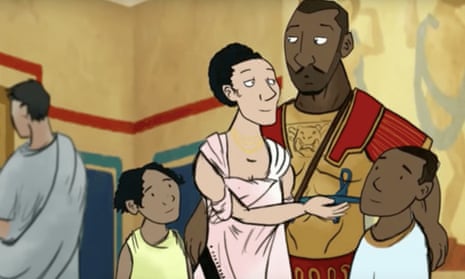The wonderful Mary Beard has been sucked into another Twitter row – where she faced, in her words, “unnecessary insult, misogyny and language of war”. This latest tussle has been about her defence (which, as usual, was measured, graceful and – above all – well-informed) of a clip from the BBC cartoon The Story of Life showing a Roman British family with a black father. For some people this was infuriating, disgusting: a politically correct piece of anachronistic nonsense, throwing modern multicultural values back on to the past. And yet, as Prof Beard has pointed out, of course it is perfectly possible, even pretty likely, that such families existed in Roman Britain, and an entirely reasonable thing for the BBC cartoon to have posited.
The Roman empire encompassed large tracts of north Africa, and even though it did not extend to sub-Saharan Africa, its borders were porous and its sphere of influence vast. “Being Roman”, it should be remembered, was not about tracing your origins to one city in Italy: as the empire grew, citizenship was extended across conquered territories. “Romans” could be from anywhere from Carlisle to Cairo, and beyond.
In Britain, there is plenty of evidence of the presence of soldiers, traders and administrators from all parts of this enormous empire, including from Africa. Some of them would have been passing through; some made a life here. What is more difficult to do is to say with certainty whether such-and-such a person was “black” or “white” in our terms: these were not categories of interest to the Romans, and in the case of elite families from north Africa, say, it’s also unclear whether they were originally Italian settlers.

So, for example, the emperor Septimius Severus, who came from Libya, and was married to the Syrian Julia Domna, ran the empire from York, England, for a period (where, incidentally, a temple to the Egyptian deity Serapis was founded). Was he black? Pass. Maybe. There was an African governor of Britain, too, in the figure of Clodius Albinus, who came from Tunisia. Again, it can’t be known for sure whether he was black or not, but it is not impossible.
In terms of Britain’s wider diversity, there is particular evidence of a man from Syria, Barates, settling down in Britain in the second century AD. We know about him because he raised a tombstone to his wife in what is now South Shields. She was a girl from Essex or Hertfordshire, a former slave called Regina. The touching inscription is in Latin and in his own language, Palmyrene. Thanks to the Roman habit of writing so much stuff down, frequently on stone, for us to read millennia later, this is all pretty clear. What is bewildering is why some people are so determined to white-out early British history.

Comments (…)
Sign in or create your Guardian account to join the discussion